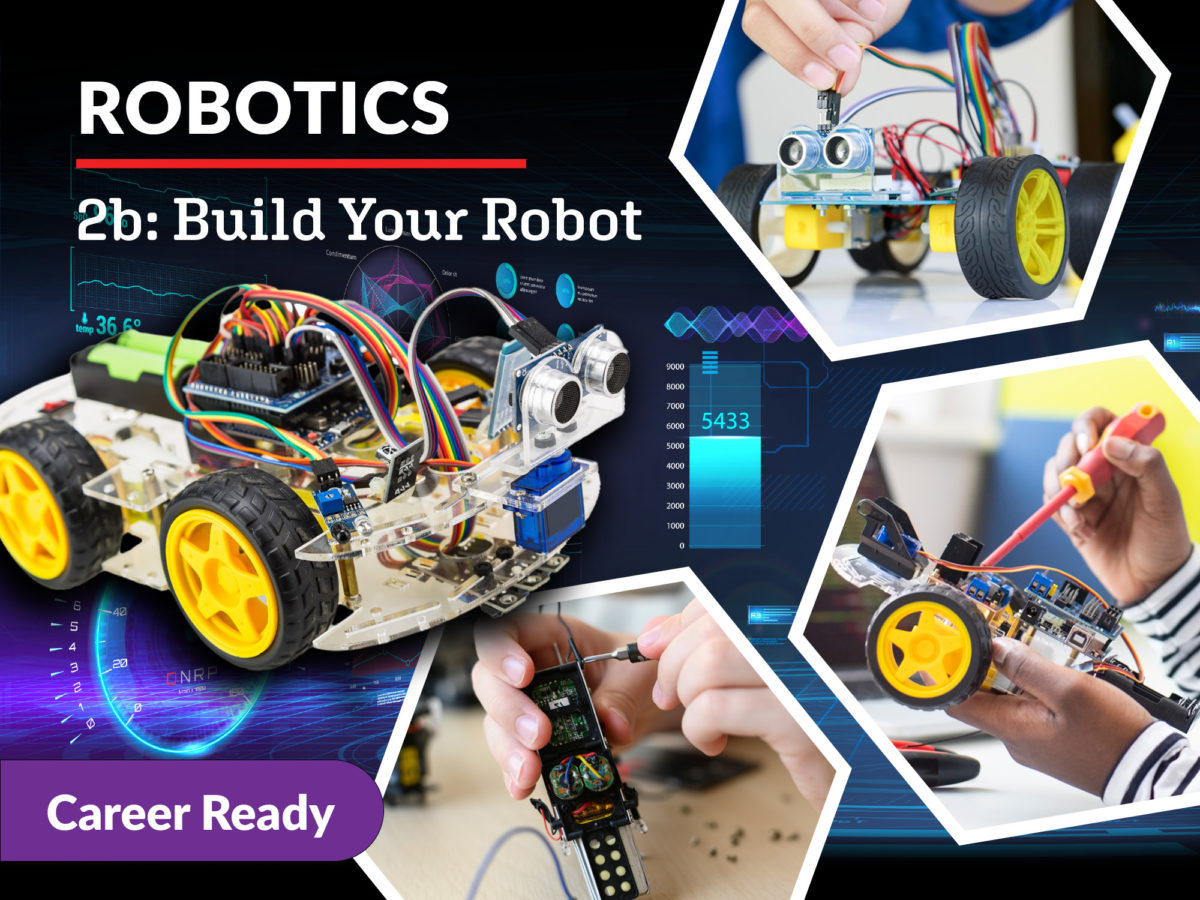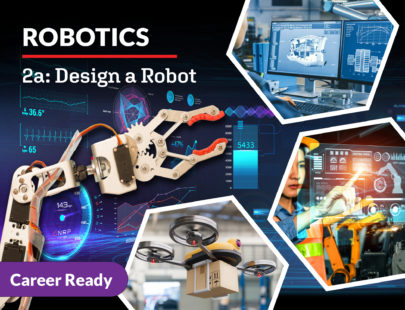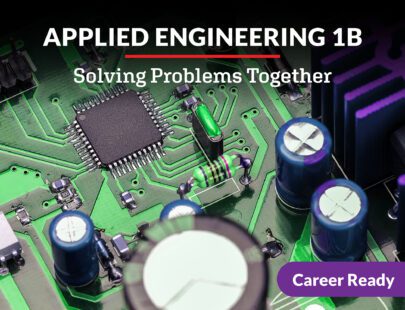
Robotics 2b: Build Your Robot
You have learned how to think like a robotics engineer, and now, it’s time to design and build like one to breathe life into your machine. In this course, you’ll explore how to add more complexity to your creations to make them more efficient, capable, and better able to handle advanced tasks. You will also learn how models and simulations can enhance robotic development and construction. After a real-world safety review, a deeper dive into advanced applications and systems, and improving your prototype, you’ll finalize and launch your robot. Are you ready to continue improving the world with your machine? Let’s automate!
Units at a Glance
Unit 1: Robot Safety
Safety is essential, and working with robots poses specific safety challenges. As you launch into more advanced robot design and building, you will be engaging in tasks that come with greater risk and the potential for risk to personal safety. In this unit we will explore various aspects of robot safety and discuss the steps we can take to keep ourselves and those around us safe. As we start to build our robots, this review will ensure that we begin on the right foot.
What will you learn in this unit?
- Understand the types of risks associated with robotics construction and wiring
- Evaluate different safety organizations and their activities
- Explain the types of safety risks related to working with or alongside robots
- Describe different types of batteries and the potential safety hazards they represent
Unit 2: Sensors and Specialized Applications
Imagine losing your five senses for a day. What would you be able to do? Just as your five senses are critical to your daily life, a robot’s sensors are critical to its ability to function. But unlike the five senses most humans and animals have, a robot requires more to function optimally, and there is a plethora of robotic sensors to choose from. How do they work? How do you use them? Let’s explore the topic of sensors some more and learn how to incorporate them into our projects.
What will you learn in this unit?
- Categorize the different classes of sensors according to the human senses that they mimic
- Explain how different sensors collect and use data from the environment to provide useful information to programmers
- Describe how sensors see data and how passive and active electrical components generate or filter data
- Classify and choose a robot control for a robotics project based on the robot’s task, the robot’s environment, and the materials available
Unit 3: What’s Up, Robot?
We’ve been talking a lot about building a robot, but what about controlling the robot? Writing code is one way to communicate with your robot, but how does it receive and use directions? What do you need to consider when giving a robot directions? These are some of the questions we will tackle this unit as we consider how best to communicate and share information with your robot.
What will you learn in this unit?
- Classify robot actions based on the subsystem that controls them
- Describe different ways robots communicate with humans and other robots
- Compare different forms of wireless communication to decide which one best fits a given situation
- Choose a method for motion planning based on a robot’s environmental conditions
Unit 4: Programming Your Robot
You’ve already learned how to code, but we have added a lot more to our tool belt since we first began this course. After a quick refresher on the theory and guiding principles behind computers and the internet, we’ll tackle some advanced tips and tricks for improving your programming skills. So, pull out your programming software, and get ready to polish your code!
What will you learn in this unit?
- Describe some of the primary components that make up computers and the internet
- Summarize how computers utilize bits to store information and use binary and hexadecimal systems to store numbers and colors
- List the main control structures and create advanced switching algorithms
- Plan and execute high-level coding using flowcharts, pseudocode, comments, variable naming, functions, and error identification
Unit 5: Improving Your Design
You have a prototype, but how can you make it better? We’ve learned a lot about best practices, but what are some practical ways you can improve your robot? Is your robot collecting a lot of data or sensor values that you are having trouble keeping track of? Is your code getting too long to manage easily? Does your robot need to follow a path, but you’re having trouble figuring out how? Here, we will explore ways that you can add more complexity to your design while making it more efficient, more capable, and better able to handle advanced tasks.
What will you learn in this unit?
- Develop arrays in a program to store, collect, and/or retrieve data
- Create a loop that uses data from an array to implement a program
- Use motor functions to map a path for a robot to follow
- Combine motor control functions with sensor-based functions to devise a closed-loop, mobile robot program
Unit 6: Heavy Lifting
The mobile robot is often the most explored aspect of robotics for students, but robotic arms are possibly one of the most widely used forms of robots. Industries have been employing robotic arms to support workers and manufacturers for decades. In this unit, we’ll take a look at special considerations for engineers designing robotic arms and how models and simulations help with their development and construction.
What will you learn in this unit?
- Identify some common types of robotic arms and describe some of the important design considerations
- Summarize how thermodynamics and pressure impact the design, construction, and use of a robotic arm
- Compare and contrast tolerance and allowance, explaining how they may be used to create a fault-tolerant system
- Define how models and simulations improve robots and help identify areas of weakness before construction
Unit 7: Test and Evaluate Your Robot
You’ve made it this far, having completed all the work necessary to design and build the first prototype of your robot. Now what? Is it safe to call it done? While you could stop here, you would be missing out on the potential to improve your design by fixing hidden problems and adding new features you didn’t think of before. Let’s learn about the important steps to finalizing your robot design.
What will you learn in this unit?
- Recall the steps of the design cycle and describe how testing applies to the development of a robot project
- Apply the steps involved during testing and evaluation in a robot project
- Compare and contrast elements involved in the process of redesigning and refining
- Explain how the Six Sigma process can be used to improve a new or existing design
Unit 8: Presenting Your Robot
Deciding when your robot is complete can be a tough decision because there always seems to be one more thing to do. And once the robot is ready, how will you share it with the public? A great product or idea is no good if it’s left on a shelf somewhere. Let’s take a look at the steps involved in bringing a robot to the market and learn more about career paths in robotics.
What will you learn in this unit?
- Justify the decision that a robotics project is ready to be closed and the robot is ready for launch
- Describe the methods for reviewing a project and identify common reasons for project failure
- Prepare a robotics presentation suitable for your audience and purpose
- Generate ideas for future career pathways in the robotics field
Required Materials
Physical
- Digital camera
- Art supplies
- Video recording device
- ELEGOO UNO R3 Project Smart Robot Car Kit V 4.0
- Arduino board
- Ultrasonic motion sensor
- Line tracking sensor
- Jumper leads or wires
- Ruler
Software
- Word processing software
- Image editing software
- TinkerCAD (requires login)
- Presentation software
- Arduino IDE
- VEXcode VR
- Google Chrome
Optional
- Digital drawing software
- Digital voice recorder
- Spreadsheet software
- Screen recording software
- Phone with camera
- Video editing software
- Mozilla Firefox








